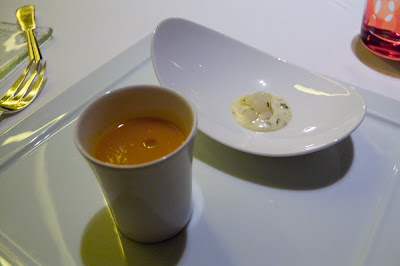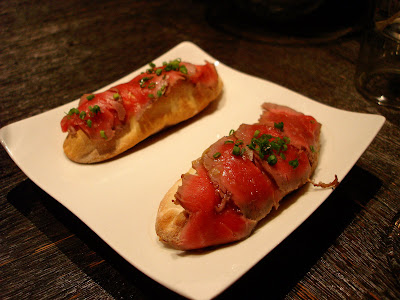
For my birthday, my girlfriend surprised me with a dinner downtown. We drove up to the Disney concert hall and I knew right away where we were going.
More...
As the namesake restaurant of the Patina Group, which includes such LA eateries as Cafe Pinot, Nick and Stef's, I had high expectations. First of all, what is a patina? It's the oxidized change in color on bronze over time. The reason the Statue of Liberty looks green--false patina. It's a concept I considered when we entered. The small dining room nestled into the Frank Gehry concert hall was comfortably lit and quiet for a late Sunday reservation. We arrived just as the show was starting; an hour earlier and it may have been packed. Our French waiter, yes he spoke French, explained the specials and signaled for the bread cart. Bacon bread--already a good sign.

The amuse of white asparagus and aioli paired with a hot carrot ginger soup certainly surprised me in contrast. The crunchy asparagus in a creamy sauce paired with the soup well, though I expected the carrots to have much more sweetness.

Although this was my birthday, the tasting menu didn't offer anything eye-popping enough. My girlfriend chose the agnolotti filled with buffala ricotta with English peas, braised scarlet turnip, and speck ham. I don't know if it's just a coincidence or if it's a generally accepted practice, but pairing agnolotti with ham is an incredible idea. David LeFevre of Water Grill had served a spectacular dish of agnolotti at the 5x5 dinner. The buffalo cheese gave the delicate pasta a heartiness otherwise absent in the thin wonton-like skins. I was puzzled by the presentation of what looked like a green lawn. The speck ham, what looks like bacon, is actually more like a smokier panchetta from an area between Austria and Italy.




For my first course, I cheated and chose the Quartet of the Sea consisting of four immaculate square plates locked into formation. From the top: smoked trout blini, seared scallop with cipollini onions, lobster citrus salad, and tuna tartare with pickled cauliflower. The trout was much more refreshing than the all-too-often used salmon in this preparation. Grapefruit and orange garnished the lobster salad, though the color reminded me too much of ambrosia (a turnoff). I am a huge fan of seared scallops, and this was no exception. I also see cippolini onions so often at these kind of dinners. Apparently, they have a higher sugar content and the small, flat shape is conducive to roasting. Tuna tartare has been done to death, though the intensely tart cauliflower gave it a contrasting crunch that was innovative.

What makes a veal chop "authentic"? According to our waiter, grain-fed veal is "authentic." But isn't that how all veal is fed? My girlfriend's authentic veal chop with sauteed sweetbreads, maple syrup glazed cipollini onions, and chanterelles tasted better than it looked. The mushrooms were richly buttered and had enough bite to savor each forkful.

One of the reasons that my significant other chose Patina was for the game menu, which varies depending on availability. That night, I ordered the rack of venison with braised chestnuts, celeriac mousseline, and a pink peppercorn quince chutney. Though the smell of the plate had all the intensity of game, the flavor was quite a bit tamer. I'm familiar with the practice of combining gamey meats with fruity compotes, but I always feel like my preference for gamer is much wilder than the average palate. With the exception of elk, gamey is always my choice.


Though my girlfriend rounded off her meal with a coconut soup with a floating island of pistachio ice cream and spherified mango juice "gnocchi" I asked to see the cheese cart instead. We enjoyed the presentation of her dessert, the components sitting in a saucer that's subsequently filled by the waiter. Those little flourishes certainly make the meal more memorable. Having consumed a pack of Red Vines per day at work, I had enough sugar in my system. I settled on a triple-creme brie, a hard Italian pecorino, and a strong roquefort. My waiter actually wasn't much help in explaining the cheeses. By this time in the meal, he had seemed to ignore our table and favored the French speaking tables instead. I hate to perpetuate stereotypes, but the rude French waiter certainly still persists.


As a post-dessert treat, we received a tray of mignardises and a napkin basket of chocolate and vanilla Milano cookies. From left to right, I think the plate consisted of a cocoa nib, passionfruit gelee, orange marshmallow, cashew
Stuffed and finished with the food portion of our meal, the manager was kind enough to take us on a tour of the kitchen. Unfortunately, Joachim Splinchal wasn't in the kitchen, but I met his sous chef Santiago instead. He explained the various prep areas of the rather large kitchen. It looked straight out of my Culinary Institute of America textbook. What struck me the most was that the kitchen was almost half the size of the dining room and still heavily staffed.
My overall impression of Patina was that I didn't feel like I belonged there. It caters to the concert hall patrons, the stuffy old white men. As out of place as I was, I noticed an Asian man scurrying his family out from a dinner too expensive to bring children. That's when it hit me. If patinas are meant to convey antiquity, this restaurant definitely has that old-world feel. Patina's certainly not part of the hot LA dining scene, but it could be a dependable standby. Plus a Michelin star doesn't hurt.
Patina
141 South Grand Ave
Downtown, 90012
(213) 972-3331
About $200 for the meal...and $8 for parking
^







































